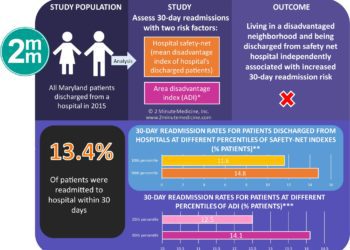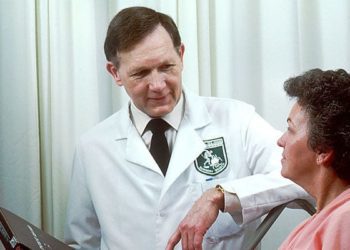Skilled nursing facility ratings linked to readmission and death rates
1. Approximately 21% of skilled nursing facility (SNF) discharges were followed by hospital readmission and 4.7% of SNF discharges were followed by death within 30 days of initial hospital discharge.
2. While the initial unadjusted analysis demonstrated a correlation between low 30-day readmission and death rates and both high SNF staffing ratings and high facility inspection ratings, the adjusted analysis demonstrated a weakened correlation with facility inspection ratings and no correlation with SNF staffing ratings.
Evidence Rating Level: 2 (Good)
Study Rundown: Hospital reimbursements for inpatient care are increasingly linked to readmission rates within 30 days of discharge. Consequently, there has been an increased focus on the potential role of skilled nursing facilities (SNFs) in providing post-discharge care to help reduce the risk of hospital readmission during this time period. This study aimed to determine whether there was an association between the quality of the SNF, as measured by various performance measures including staffing ratings and facility inspection ratings, and the risk of hospital readmission or death within 30 days of hospital discharge.
Overall, the study demonstrated an inconsistent relationship between performance measures and the risk of 30-day hospital readmission or death. While there was an initial association observed between low 30-day readmission and death rates and high SNF staffing and facility inspection ratings, this association was either weakened or disappeared when the analysis was adjusted for pertinent patient, SNF, and hospital discharge factors. Given the inclusion of only fee-for-service Medicare patients in this study population, limitations of this investigation relate to its generalizability to other patient groups. Nevertheless, the large number of discharges and SNFs evaluated allow this study to shed light on the limitations of currently available SNF quality measures in affecting readmission and death rates. Further research is required to identify alternative SNF performance measures or other influencing factors to help guide future strategies for improving post discharge readmission and death rates.
Click to read the study, published today in JAMA
Click to read the accompanying editorial, published today in JAMA
Relevant Reading: Rehospitalizations among Patients in the Medicare Fee-for-Service Program
In-Depth [retrospective study]: This study evaluated 1,530,824 discharges from 3,537 hospitals to 14,251 SNFs in the United States. Of 1,530,824 discharges to SNFs, 321,709 were followed by readmission within 30 days (21.0%; 99%CI 20.9%- 21.1%), and 72,472 were followed by a death within 30 days (4.7%; 99%CI 4.7%- 4.8%). In unadjusted analyses, the risk of readmission or death within 30 days was lower for discharges from SNFs with better staffing ratings and facility inspection ratings. While SNFs with the lowest staffing ratings had readmission rates of 25.5% (99%CI 25.3%-25.8%) and those with the highest staffing ratings had rates of 19.8% (99%CI 19.5%-20.1%), SNFs with the lowest facility inspection ratings had readmission rates of 24.9% (99%CI 24.7%-25.1%) versus 21.5% (99%CI 21.2-21.7%) for those with the highest ratings. When the analysis was adjusted for pertinent patient, SNF, and discharging hospital factors, there was no difference in the 30-day risk of death or readmission for SNFs with the lowest versus highest staffing rating. There was a modest difference (23.7% versus 23.0%) in the adjusted 30-day risk of death or readmission for SNFs with the lowest versus highest facility inspection ratings.
More from this author: Reducing surgical complications may increase costs, Protected sleep periods improve intern alertness and sleep duration, ADHD medication decreases rates of criminality in ADHD patients, Low dose aspirin shows net clinical benefit in patients with first unprovoked venous thromboembolism, Rare TREM-2 mutation implicated in Alzheimer’s Disease
Image: PD
©2012-2014 2minutemedicine.com. All rights reserved. No works may be reproduced without expressed written consent from 2minutemedicine.com. Disclaimer: We present factual information directly from peer reviewed medical journals. No post should be construed as medical advice and is not intended as such by the authors, editors, staff or by 2minutemedicine.com. PLEASE SEE A HEALTHCARE PROVIDER IN YOUR AREA IF YOU SEEK MEDICAL ADVICE OF ANY SORT.







